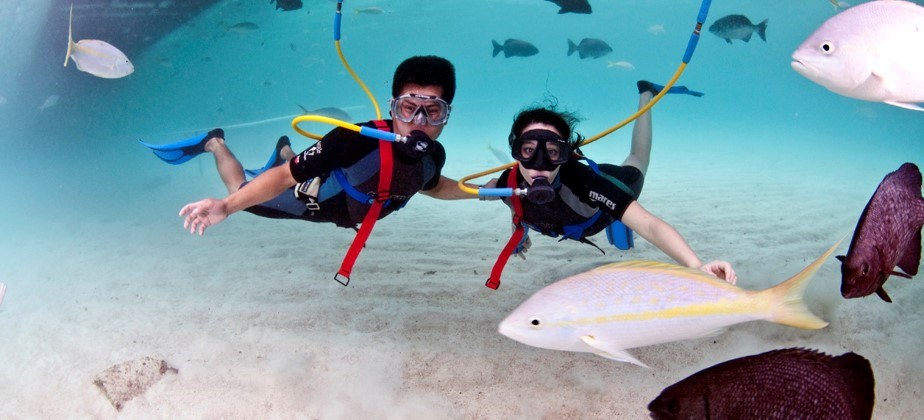For decades, those who wanted to see the wonders beneath the surface of the sea had to either peer at them from afar through a snorkeling mask or invest the time (and money) to become a certified scuba diver. But a middle way has opened, and I’ve interviewed one of the promoters of this exciting new sport, Duane Beggs, of Snuba International.
Pauline Frommer: Very briefly, what is Snuba?
Duane Beggs: Snuba is a transition between snorkeling and scuba diving. It’s basically done with a tank and all the equipment on a flotation device on the surface that’s connected to a 20-foot hose that goes down to the diver.
Frommer: Why would anyone want to do this when he or she could scuba dive, which would allow them to go deeper?
Beggs: Scuba diving has an initial trauma to it, in that they put 80 pounds of gear on you, and your mind tells you you’re going to go to the bottom like a rock. Not necessarily so, but it’s a mental thing. With Snuba, you have a flotation device that gives you level of comfort. You have a limit to the depth you can go. You don’t have to wear any equipment, and there’s a limit to the amount of instruction you need before the experience.
Frommer: So there’s much less training. Does that mean that there’s less training needed?
Beggs: Yes. With Snuba you’re attached to a surface raft, so you don’t drift off to any depth. We teach you to hang on to the raft with your mask and regulator until you’re comfortable. And then you climb hand over hand down the line. This also makes it easier to regulate your ears. If you get too deep, it’s very difficult to pop your ears; you have to come back up. Coming up and down isn’t an easy thing when you’re freefloating in the ocean, because you don’t know where you are. But with Snuba, you go down the hose a few feet and pop your ears, and then do it again. If it doesn’t work, you can go up a couple of feet. You can stop on that hose anywhere you want. If you want to stay at 5 or 10 feet, you can. That’s fine.
Frommer: You’re approaching this like it’s a positive thing. But I bet a lot of people would wonder if what you’ll see will be interesting at just 20 feet.
Beggs: What you find is once you go past 30 feet, you lose the colors. Most of the reds and yellows are filtered out by the salt water. Most of the aquarium fish are in shallow water. The main advantage of Snuba over snorkeling is that at least half of the things that live in the ocean live underneath the coral, not on top of it. So once you go down and you can look under, you see a lot that you wouldn’t see otherwise.
Frommer: Where can you find Snuba diving today?
Beggs: We’re in about 60 different locations worldwide. The largest concentrations are Hawaii, Mexico and the Caribbean. We’re in most of the places where cruise boats stop. We’re one of the main concessions for the cruise lines. You can find all of the locations at Snuba.com.
Frommer: This sounds like something my kids would love. Is this an all-ages activity? Is it safe enough for children?
Beggs: We go down to 8 years old to do the full Snuba experience. For those ages 4 through 8, we have something called “Snuba Do.” That basically replaces the harness with a flotation device that’s actually a full vest, so that toddlers can stay on the surface with the raft and feel like they’re doing the same thing as their parents without going under the water.
Frommer: Well, it’s a fascinating alternative for vacationers. Thank you so much for talking with me.
* * * Note to the reader: Please be sure to confirm all rates and details directly with the companies in question before planning your trip. The information in this column was accurate when it was released, but prices are competitive, sometimes limited and can always change without notice.
*** Pauline Frommer is the Editorial Director for the Frommer Travel Guides and Frommers.com. She co-hosts the radio program The Travel Show with her father, Arthur Frommer and is the author of the best-selling Frommer’s EasyGuide to New York City. © 2016 by Pauline Frommer Distributed by King Features Syndicate
